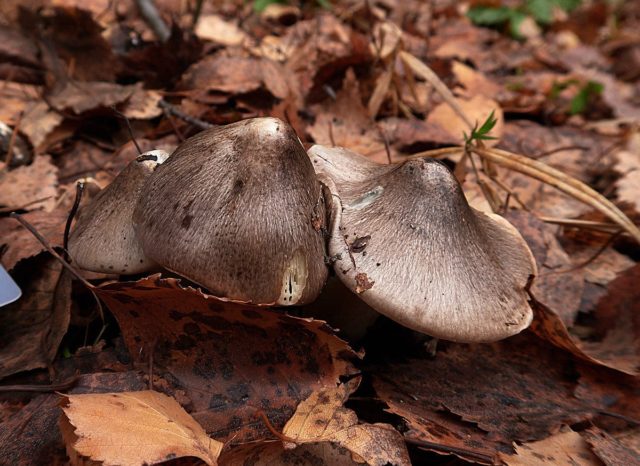Content
Fiberwort is a member of the Fiberwort family, genus Fiberwort. This mushroom is often confused with sulfur row or honey mushrooms; it is also called torn or torn fiber. Eating this specimen accidentally can cause a lot of trouble for a person, since it is a toxic hallucinogenic mushroom.
What does acute fiber look like?
Considering the variety has the following characteristics:
- The cap of a young specimen is bell-shaped, over time it becomes flat-convex with a sharp tubercle in the center. Its size varies from 2 to 8 cm in diameter. As a rule, the edges are torn, which is why it received the corresponding second name. With age it completely cracks.The surface is silky-fibrous brown in color with a darkened tubercle in the middle.
- Under the cap there are frequent, wide and stem-free plates. When young they are light gray or yellowish in color, then gradually acquire a richer dark brown hue.
- The pulp of the pungent fiber is pale yellow or white; it does not change color when cut. It has an unpleasant taste and aroma.
- The leg is cylindrical in shape with a slightly widened base, the length of which is 2-4 cm, and the thickness is 0.2-0.4 cm. The upper part is light with a powdery coating, and below it acquires a red-brown tint. Slightly widened at the base.
- The spores are smooth, angular in shape. The spore powder is colored brown-tobacco.
Where does acute fiber grow?
Acute fiberwort is common in Eastern Siberia and Europe. It is found in coniferous and deciduous forests among sphagnum mosses, in swamps, and can also hide in the grass along roads. The optimal time for development is the period from late June to October.
Is it possible to eat spicy fibre?
This mushroom is classified as inedible. In some reference books it is listed as poisonous. Eating it can cause a hallucinogenic state similar to intoxication. In some cases, it causes addiction, since this component has a narcotic effect on the body. Spicy fiber has no culinary value, so it is not collected. It should also be noted that heat treatment is not capable of destroying the toxic substances found in the mushroom.
Similar species
As a rule, a huge variety of mushrooms are found in the forest, which in certain characteristics are similar to the acute fibre. Experts identify the following doubles:
Gray row – has a conical, pointed cap with cracks on the surface, similar to the species in question. However, the leg of the first one is much wider, and it also exudes a pleasant mealy aroma. Is edible.
Honey mushrooms – these small mushrooms are very similar in shape and color to the acute fibre. The main difference between the first option and the second is the ring on the stem. In addition, honey mushrooms always grow in large groups. They are classified as edible mushrooms.
Bristle-footed garlic - inedible mushroom. Outwardly, it resembles acute fiber, but the former has a much smaller fruiting body, the cap reaches no more than 1 cm in diameter.
Symptoms of poisoning
After the first 30 minutes after eating spicy fiber, a person may feel the following first signs of poisoning:
- severe abdominal pain;
- diarrhea;
- increased sweating and salivation;
- vomit;
- cardiopalmus;
- breathing disorder.
Having reached the maximum level, all symptoms begin to gradually decrease and should completely disappear within 24 hours. In case of severe poisoning with this component, there is a risk of cardiac arrest and pulmonary edema, which can subsequently lead to death.
First aid for poisoning
Undoubtedly, you cannot do without medical assistance, but pre-medical measures must be carried out independently. The main goal is to remove the poison from the body and reduce the concentration in the blood.To do this, the victim should take adsorbents and rinse the stomach with a large volume of water.
Conclusion
Fiber is a dangerous mushroom; eating it can cause a lot of trouble for a person. If ingested, the victim must be given first aid, and then urgently hospitalized for the necessary treatment. In order to avoid unpleasant situations, the mushroom picker should carefully approach the choice of forest gifts and more thoroughly study the characteristic features of each specimen.














